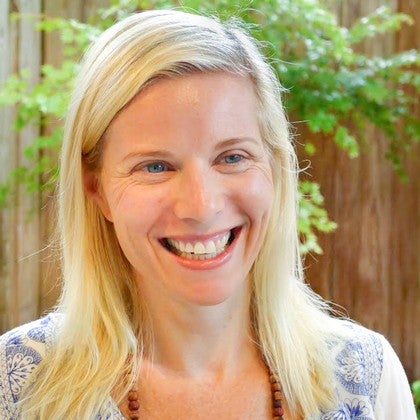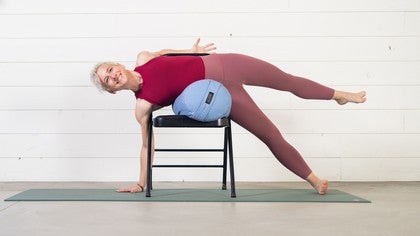
Meridians Decoded
At his 10-day advanced training in California, I caught Erich Schiffmann just before he slipped out for the afternoon and asked him: “Is yoga for you these days more about flexibility or energetics?” Without pausing, Erich looked at me seriously, as if to make sure he was guiding the point into my soul.
“Energy,” he said assuredly, with that deeply-loving Papa Schiffmann smile.
At the time, I was starting to feel this in my own yoga practice. I still saw yoga as a useful means for maintaining mobility - but what was becoming more evident to me was that yoga had an extraordinary way of shifting my energy.
I would leave a yoga session with the same amount in my bank account and the same issues with my mom, but somehow my mindset had been restructured by the practice. The nagging barriers to my wellbeing (my parent’s imminent divorce, the colleague at work who annoyed me) seemed less like obstacles and more like innocuous buoys bobbing along the surface of my existence.
How was this possible? How did a handful of Sun Salutations and few Pigeon poses completely shift my frame of mind?
I remember being taught the three major nadis: sushumna, ida, and pingala. I memorized them for my exam, but that was about all I gathered from the yogic perspective on energetic channels. I knew enough to pass a teacher certification, but not enough to make the theories feel applicable. The true energetics of the body alluded me - until I stumbled upon the meridians of Chinese Medicine.
A childhood friend named Robin had moved back from California as a licensed acupuncturist and herbalist and happened to rent a space in my first yoga studio. I made an appointment with her merely out of support, but when I sat down for my consultation, Robin revived my intrigue by asking the most intimate and nuanced questions I had ever been asked in my life. From my answers, she gleaned an interpretation of my health that bordered on clairvoyance.
All the strange symptoms that had been dismissed by my medical doctors made sense to Robin. Whereas before, the picture of my health seemed random, she was able to weave my responses into a pattern, like a quilt telling a story.
We all have those pestering tribulations that harass us: headaches, insomnia, digestive drama, night sweats, depression – I can go on and on. But often these harassments, while vaguely debilitating, are not enough to send us running to a doctor. Sometimes we know exactly why these conditions arise in our lives, but more often than not, we allow a handful of these woes to be written off as “unexplained.”
I had been taught prana, but I felt prana for the first time when the needles pierced my skin and tapped into my rivers of chi. The electricity I felt was undeniable; there was indeed an energetic life force within me – call it prana or chi – and I became desperate to learn everything I could about how it flowed and how I could affect this flow. By working with my body’s energetics, I knew I could quell less-severe but pestering issues like eye pain and irritability.
After years of working with Robin, she moved to another state and I was suddenly struck with the grave realization that acupuncture was expensive. I had been trading rent with her for treatments and I started looking for a DIY way to get the benefits of acupuncture. I’d felt yoga shift my energy. Could I use yoga in a more specific manner to purposefully shift the chi of my meridians?
Nearly a decade later, my questions ripened when I sat at a workshop in Savannah, GA and Sarah Powers opened with the declaration that she saw yoga as a form of “needle-less acupuncture”. My ears perked and my spine straightened. The rest of the weekend, she investigated with us what I had been longing to explore: yoga, not only as a workout but as a roborant therapy for mind-body-soul energetic healing.
So what’s useful about considering the meridians when we practice yoga?
We are affecting the energetic channels of our systems whether we know it or not. We might as well start to appreciate and understand these channels so that we can utilize yoga’s fullest potential of energetic healing.
I was once told by a masterful acupuncturist and yogi that when energy is moving through the body without restriction, we feel no pain. Yoga provides us a glimpse of this unrestricted energy – even if only for a few seconds at a time. This is precisely why most of us return to the mat again and again: not for the loosening of our hamstrings, but for the liberation of our chi. We feel this internal liberation as fewer aches and pains in our joints, but also as peace of mind: a deeply calming sense of knowing. Meridians and yoga are very compatible, a wholesome team.
So where exactly are all these so-called rivers of energy located in the body? When we practice yoga, where should we focus physically to affect the energetic meridians?
There is a beautiful explanation of the Modern Meridian Theory in Paul Grilley’s book. But essentially, it is theorized that the meridians exist in the fascia and travel along fascial lines through the “water” of the body. Since every cell of your body needs chi to survive, it makes sense that the most ubiquitous tissue in the body - your fascia - would be the carrier for your chi.
Grilley once lectured during a training that perhaps we shouldn’t view yoga as actual acupuncture. After all, Grilley expounded, acupuncture uses needles with hairline, pin-prick precision; the yoga stretches we use to access and nourish the fascia (and therefore, the meridians) are a “dull instrument” comparatively.
But this is a good thing. Because it means that you don’t have to be precise in your energetic pursuits in the realm of your yoga practice. You can be free to experiment cautiously, but confidently.
Unless you want to pay the tuition and spend at least four years in school to learn Chinese Medicine, you should probably just stick to the basics of acupuncture and use your yoga practice to heal yourself energetically in a broad-sweeping way: use your yoga less as a specific tool of exactness and more as a refresher of the meridians, a tonic.
We want the energy of the body to flow in a smooth manner and yoga has a way of smoothing out the body’s energy. Yoga helps evenly distribute the traffic on our meridian highways. Yoga does this by imparting pressure on the tissues of our bodies through movement and stretching which affects the fascia and therefore affects the flow of chi in our meridians.
If you are feeling up for a healthy goal, try some of the series geared for specific organ systems in Powers' book. Like me, I hope you’ll discover a reliable energy-shifting technique that comes in handy when you have small aches and woes. I am amazed by my body’s ability to stabilize when I give it space to settle.
It may not happen overnight – this is not the quick-fix pill of modern medicine. But if you have the desire and the will, revealing the energetics of your body through yoga may just help you achieve a soundness that is undeniably transcendent.
Check out Arturo Peal's show, Rest Deeply, to try some practices using yoga and self-massage techniques to access the meridians of your body.
Comments
No comments yet. Be the first!








You need to be a subscriber to post a comment.
Please Log In or Create an Account to start your free trial.